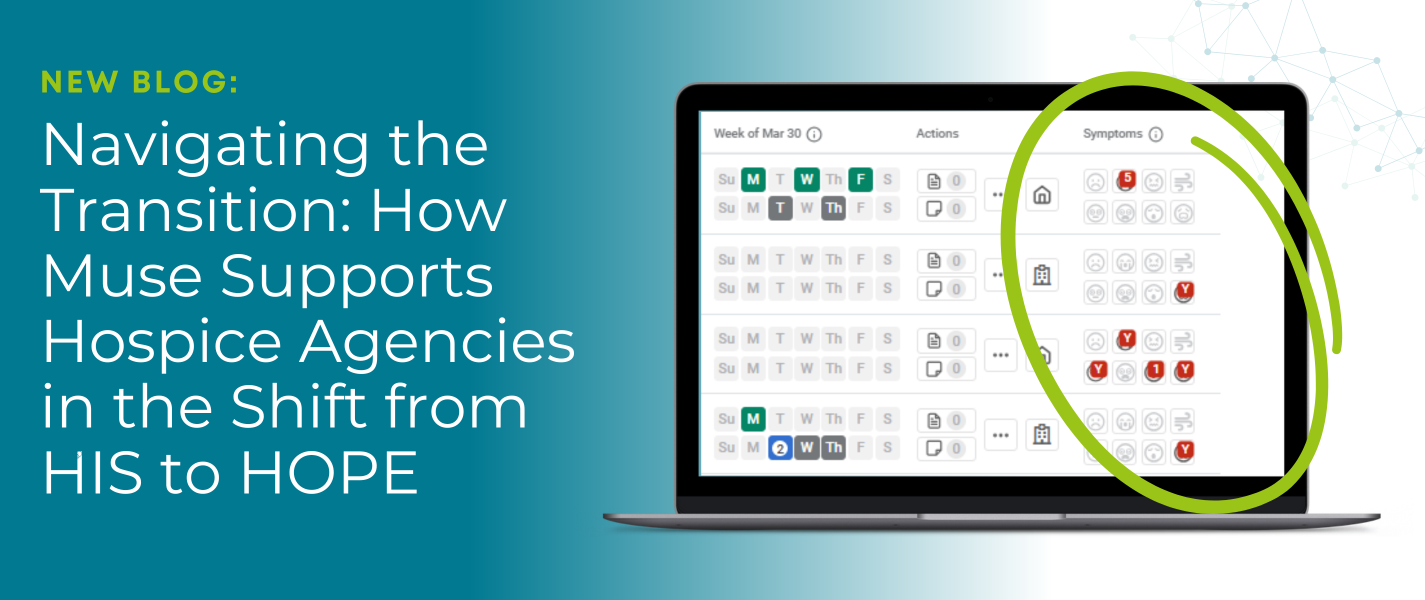Successfully Navigating the “Grey Area” between Home Health and Hospice: Considerations and Strategies for Home Health Operators
Amanda Fabozzi, PT, DPT
Whether a patient should be served by home health versus hospice may not be black and white, especially during a “one step forward, two steps back” scenario. Consider the chronically ill patient on home health who may be well known to staff because of multiple past admissions (and discharges). The patient revolves on and off home health services but with each admission, they are a little sicker and more medically fragile, with positive outcomes harder and harder to achieve. This patient falls in a “grey area” of care because the most appropriate care setting may be unclear and even disagreed on by clinicians.
As the industry continues to shift further into value-based care and staffing challenges remain at critical levels, let’s examine a few core challenges for home health operators, and why it’s imperative to carefully and objectively evaluate whether a home health care setting meets the unique needs of a higher-risk patient. We’ll also look at how predictive analytics can bring greater clarity to patient cases in the grey area by providing timely clinical decision support.
Home health operators, clinicians, and patients encounter tough challenges in the grey area.
1. Negative outcomes can occur, despite HH intervention.
As a home health operator, have you ever come to the frustrating conclusion that no amount of care or combination of interventions could have prevented a hospitalization? Repeated hospitalizations and ER visits serve as warning signs that the level of care a patient requires may exceed what can be safely provided by home health. Earlier intervention, including richer collaboration with transition navigators around long-term planning, can ensure that high-risk patients receive care in the most appropriate setting to meet their needs and wishes. More time spent in the right setting can reduce the risk of negative outcomes.
Consider a patient’s functional status. Restoration of function is the goal, yet sometimes this is unattainable due to inevitable disease progression. A patient may fail to improve – or even decline – with restorative interventions once their disease reaches a certain point. Yet the same care often continues, with the patient likely unaware of their prognosis and alternative care options. Failure to closely examine the care plans for these patients can lead to negative outcomes for both patient and agency, and a lack of clarity from the patient record can make this planning difficult.
2. Higher acuity patients and limited resources are here to stay.
A core “lose sleep at night” challenge in the industry is how to recruit and retain staff. Many agencies encounter severe staffing shortages and must strategically and creatively allocate resources based on patient needs. Continuously maintaining an up-to-date understanding of patient acuity across the entire census is a major challenge, but addressing this challenge is a must. When a patient’s acuity level exceeds what can be adequately addressed with intermittent home visits, nursing staff are stretched to provide care, limiting their capacity to help others and leading to burnout. Recent reporting from the US Department of Health and Human Services found that 35-54% of nurses report burnout, a continuation of a longstanding trend. Early identification and prompt care collaboration on these cases can lead to clinically informed and proactive care planning that can help mitigate the challenge of staffing day-to-day visits.
3. “Goals of care” discussions are hard but enhance the patient experience.
As a home health operator, do you feel that your clinical teams lack the knowledge or confidence to lead productive “goals of care” discussions? The reality is that home care providers may treat with tunnel vision and may not be able to effectively lead difficult end-of-life conversations. This is likely not their fault, especially if they lack understanding of the hospice benefit. Patients may be quick to refuse hospice if the discussion does not focus on education and goals of care. Likewise, clinicians may be quick to state “patient declines hospice” having not provided adequate information to equip the patient to make an informed decision.
Consider this example: A clinician may be unaware that hospice services are generally well covered by Medicare, with the patient able to access aide services, equipment, and medications at minimal to no cost. Failure to identify the patient’s care priorities, followed by failure to provide education about hospice coverage, can lead to a missed opportunity to best meet the patients’ needs and wishes. When clinicians aren’t fully supported and educated, they can in turn have trouble supporting and educating patients.
4. Interdisciplinary care collaboration can be challenging.
When a transitions navigator attempts to facilitate end of life planning for a patient, home health teams may feel strongly that hospice is not the answer. Without the right technology to bridge the gap between these siloed teams and provide data to facilitate dialogue, appropriate and timely transitions may not occur. With 54% of hospice patients utilizing less than 30 days of the benefit, anything that can be done to streamline the evaluation process is worthwhile.
What steps can home health teams take to address these challenges?
Patients who fall in the grey area are complex to manage, so it’s important that home health teams understand that failure to identify and collaboratively evaluate these patients can lead to negative consequences for both patient and agency. So how can home health operators intervene to ensure that the patient’s unique needs are being met?
- Closely monitor high-risk patients. Collaborate with transition navigators and supporting technology to identify high-risk patients and plan time to discuss these patients frequently during their episode of care. Pulse Transitions helps navigators and clinical managers alike by surfacing key predictive data and trends from the patient record including a mortality risk level that may suggest a potential change in care setting. It also stratifies patients by risk to focus attention on pressing cases. Interdisciplinary discussions, fueled by this clinical evidence, can surface new issues and generate solutions for timely, consistent intervention. It is critical that clinical team members remain informed regarding the patient’s status so that care is provided safely and with a team approach.
- Educate your home health teams. Plan to regularly educate your home health staff on different levels and types of care, including details regarding benefits and eligibility. It may also be beneficial to provide specific training on how to introduce an end-of-life conversation, designate an appropriate team member to assist, and collaborate with transition navigators to facilitate. Equipped with this knowledge and confidence, clinicians can educate their patients and encourage them to think about the future. Who better to introduce a difficult conversation than someone the patient knows and trusts? Once the topic has been broached, clinicians can use the supporting detail surfaced by Pulse Transitions to substantiate care recommendations, both internally and to the patient. Patients and families report greater satisfaction when they fully understand their options.
- Provide the patient with information and resources to support their needs. A patient may decline a higher level of care despite being fully educated on hospice and knowledgeable about their condition and their options. This is ok, and this is their right. It is our duty as providers to ensure that the patient has all the available information to make this decision for themselves, and clinicians should be well versed in available care options. For instance, if a patient does not feel ready for hospice, providers should be prepared to offer other options such as social work or palliative care consults to help with resources or symptom management. They should also be prepared to revisit the subject at a later date to determine if the patient’s wishes have changed. Sometimes it means stepping outside of our comfort zone, but it ultimately can make all the difference for a patient approaching end of life. Using a technology solution like Pulse Transitions can help providers identify when conversations on these topics should occur, with follow-up tools to make sure nobody falls through the cracks.
- Capitalize on technology. Timing an end-of-life conversation is difficult when home health clinicians are solely relied upon to recognize subtle decline. Pulse Transitions applies breakthrough machine learning and predictive analytics by leveraging home health data to identify patients on the home health census who are likely to pass away in the upcoming 60 days. The solution serves as a starting point for providers and caregivers to facilitate compassionate, timely end-of-life conversations that serve to direct advanced care planning decisions. Knowing when evaluation should start and having the support of advanced analytics can be a powerful boost for your clinical team to feel more confident and better equipped to navigate difficult patient conversations. In addition, Transitions improves working relationships between home health clinicians and transition navigators, providing transparency into the hospice evaluation process and tools for cross-functional collaboration.
Technology-supported, risk-based monitoring and timely, clinically informed action when managing patients in the grey area between home health and hospice can make all the difference. From the patient’s perspective, knowledge can empower participation in care planning so that patients have the opportunity to receive care in the most appropriate setting to meet their goals. From the provider’s perspective, improved quality and patient satisfaction will likely result from the same conversations around goals of care. Complex cases are always a challenge but can be easier to manage when tapping into your resources and taking action – even small steps – to ensure that you and your teams are dynamic and prepared to collaborate. To learn more about how Pulse Transitions can help you take these steps, take a look at our product page and schedule a demo.
Related Blogs

Navigating the Transition: How Medalogix Muse Supports Hospice Agencies in the Shift from HIS to HOPE
Authored by: Steven Shelton, MBA, MSN, RN, CHPN; Senior Director, Clinic...

Forcura and Medalogix Join to Create Transformative Post-Acute Care Technology Platform
Berkshire Partners Will Serve as Lead Investor in the New Platform, with...

HHVBP: A Winning Strategy for Home Health Providers
The start of 2025 has ushered in a wave of new realities for Home Health...


